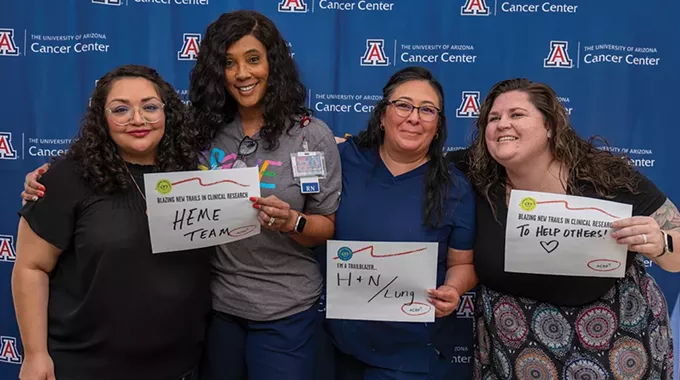
The University of Arizona Cancer Center has long been at the forefront of breast cancer research and treatment. Lately, the center has become deeply involved in the nationwide push toward precision medicine and targeted therapies, contributing to better outcomes for breast cancer patients, particularly those from historically underrepresented populations.
There’s just been one problem.
“In the past, the majority of patients who were enrolled in the studies were white,” said Dr. Sima Ehsani Chimeh, the center’s Breast Clinical Research Team leader. “We didn’t have good representation of other ethnicities, and we don’t know if the results would apply to all the patients.”
That’s now changing. Ehsani Chimeh said the center has boosted its commitment to ensuring diverse populations are represented in clinical trials. That’s not just to ensure that new breakthroughs in breast cancer research and treatment benefit everyone, regardless of race or ethnicity — although that’s certainly part of the mission.
By broadening the inclusion of different demographics in research, Tucson’s doctors also hope to develop more effective and personalized treatments for multiple populations. And the region is particularly well-positioned to lead in that area.
“Because of the unique population we have here in the Southwest — especially the Hispanic population, and also the good representation of Indian populations — we think that the University of Arizona and the catchment area is just a very important location for including those patients in the studies.”
Already the school’s researchers have identified some “concerning” shortcomings in previous methods.
“We have some data and evidence suggesting that some of these studies and some of these genomic assays that we are using to help us make decisions for treatment of patients, they may not be very inclusive, and they may not be very applicable to some populations — for example, African American patients,” Ehsani Chimeh said.
“There are some studies suggesting that the breast density might be different in African American patients, and there are other differences in that group that could affect the disease and also the treatment of cancer — like BMI and insulin resistance.
“Also, we see some germline mutations in other ethnicities that we do not necessarily see in other patients,” she added. “For example, last year we talked about the BRCA mutation and that it’s more common in Ashkenazi Jewish people compared to other patient populations. So there are lots of things that can be affected based on race and ethnicity, and we’re being more attentive to that.”

Targeted treatments
But it’s not just about who’s participating in the trials. It’s also about changes in how breast cancer is treated.
In recent years, the focus in cancer treatment has shifted to precision medicine, an approach that moves away from the traditional “one-size-fits-all” model of treatment, focusing instead on the genetic makeup of the tumor, allowing for more personalized and effective therapies.
“We are moving more and more to precision medicine and targeted therapies,” said Ehsani Chimeh. Part of the goal is to reduce reliance on the older, more toxic chemotherapy drugs. “We are trying to minimize that as much as we can. We’re trying to find targets that we can treat better, with less side effects and more precision.”
This shift is perhaps most evident in how doctors now treat HER2-positive breast cancer. “Since the 1990s and early 2000s, we’ve developed multiple generations of anti-HER2 medications or anti-HER2 antibodies,” Ehsani Chimeh said. “The prognosis has gotten much, much better.”
HER2-positive breast cancer, once considered highly aggressive, now responds well to a class of drugs called antibody-drug conjugates (ADCs), which deliver chemotherapy directly to the cancer cells without harming healthy cells. “The hope is we can improve the therapeutic response for the tumor without harming the healthy cells.”
The center is also working to target HER2-low breast cancer, a subtype where the HER2 protein is expressed at lower levels. “We have seen some data that some of these anti-HER2 medications can work in patients with cancers that have small expressions of HER2,” Ehsani Chimeh explained. New clinical trials are exploring how ADCs can be effective even in these challenging cases.
Then there’s triple-negative breast cancer (TNBC), an aggressive form of breast cancer that lacks both hormone receptors and HER2 expression. Historically, it’s been one of the hardest types of cancer to treat.
“For triple-negative breast cancer, we did not have many treatment options other than chemotherapy,” Ehsani Chimeh noted. However, recent advances in immunotherapy have been game-changing. “More recently in the past couple of years, we have been using immunotherapy for treatment of triple-negative breast cancer,” she said. This emerging treatment harnesses the power of the immune system to attack cancer cells more effectively.

Menopause, hormones and breast cancer risk
Breast cancer doesn’t exist in isolation. It’s deeply intertwined with other aspects of women’s health — especially menopause.
For Dr. Arianna Sholes-Douglas, a board-certified gynecologist and founder of Tula Wellness & Aesthetics in Tucson, understanding this connection is key to helping women navigate breast cancer risk and hormone therapy.
“There’s a lot of confusion around hormone therapy and the role that it can have in breast cancer,” Sholes-Douglas explained.
After a landmark 2002 study raised concerns about hormone replacement therapy (HRT) increasing breast cancer risk, many women and their doctors became wary of using hormones to manage menopause symptoms. “That study pretty much informed a whole generation of doctors on how to manage — or to mismanage — menopause,” she said.
However, in recent years, research has shown that hormone therapy may not be as risky as once thought — especially when used appropriately. And with the advent of personalized breast cancer screening, doctors are now able to assess a woman’s specific risk factors, such as family history, genetics and breast density, to make more informed recommendations.
“Breast cancer screening is becoming more and more personalized,” said Sholes-Douglas.
One major development in breast cancer screening is the FDA’s new mandate requiring imaging centers to notify women if they have dense breasts, a condition that can increase both cancer risk and the likelihood of missed diagnoses. As of Sept. 10, all mammography facilities are required to include a breast density assessment as part of a patient’s medical report.
“Women who have dense breasts have more dense tissue as opposed to fatty tissue and it makes the imaging more difficult,” said Sholes-Douglas. “And so they also have a higher risk for their cancer not to be detected because the density makes it harder to image.” This new mandate is meant to empower women with the information they need to advocate for more comprehensive screening, like MRIs, when necessary.
As Ehsani Chimeh noted, higher breast density is more common among African American women compared to women of other racial or ethnic groups. But Sholes-Douglas said there are other unique concerns for this population.
“African American women are affected with typically a more aggressive form of breast cancer, and are more likely to die from a breast cancer diagnosis,” she said. “Part of that looks to be something genetic, but a lot of that is also a factor of those social determinants of health – like income status, access to medical care, access to healthcare insurance.”
The larger shift toward more personalized and inclusive breast cancer care should help address at least some of those inequities — not only in this population but throughout Southern Arizona’s many racial and ethnic groups. And the drive to include more diverse populations in clinical trials may go a long way toward ensuring that these treatments work for everyone, not just a select few.
“I’ve tried to emphasize that it’s very important that our diverse patient population needs to be included in the studies going forward, because we want to get more information about these patients and make sure all patients benefit from these advancements,” said Ehsani Chimeh. “And our location, with all its diversity, is the perfect place for that to happen.”











